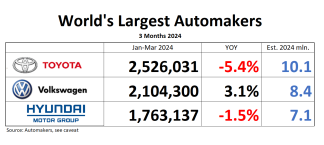WHEN President Obama announced in March 2009 that his administration would guide General Motors and Chrysler through a government-financed bankruptcy, he made it clear that the taxpayers’ $80 billion would buy nothing less than a sweeping transformation of the entire auto industry.
“This restructuring, as painful as it will be in the short term, will mark not an end, but a new beginning for a great American industry,” he said, “an auto industry that is once more outcompeting the world; a 21st-century auto industry that is creating new jobs, unleashing new prosperity and manufacturing the fuel-efficient cars and trucks that will carry us toward an energy-independent future.”
Now, nearly a year and a half after the two automakers exited bankruptcy, the administration has defined down the goals of the bailout, focusing on G.M.’s and Chrysler’s return to profitability and job creation. Though these are promising developments that show the bailout has not been an unmitigated short-term failure, the new emphasis shows just how far the industry is from the kind of transformation we were promised.
In particular, what Mr. Obama called his “one goal” — having Detroit “lead the world in building the next generation of clean cars” — is nowhere near being achieved. While the idea of improving G.M.’s and Chrysler’s fuel efficiency was doubtless a politically popular justification for the bailout, American consumers have not embraced the goal with equal fervor. Sales of fuel-sipping compact and subcompact cars have actually dropped this year, while pickup and sport utility vehicle sales grew by double-digit percentages.
This dynamic is not limited to Detroit, as Honda and other foreign producers have seen their sales this year grow largely on the backs of light trucks. But, as the king of S.U.V. and pickup sales, Detroit has been the main beneficiary of the market’s continued preference for less-efficient offerings.
At General Motors, sales of actual cars this year have fallen by nearly 6 percent compared with last year’s anemic numbers, while light trucks (which include pickup trucks, S.U.V.’s, minivans and crossovers) are up by more than 16 percent. Despite rolling out the much-hyped Cruze compact and the Volt plug-in hybrid, G.M. still sells half again as many trucks and S.U.V.’s as it does cars. This year 73 percent of Chrysler’s sales have been light trucks.
It’s true that most modern crossovers are more efficient than the truck-based S.U.V.’s that kept Detroit afloat in the 1990s. But American producers collectively remain a long way from contending for green car leadership. According to the Environmental Protection Agency, the Detroit automakers have three of the four lowest average fleet fuel economy ratings among full-line manufacturers, and none achieves the industry average of 22.5 miles per gallon.
Detroit seems aware of this troubling dependence on trucks and S.U.V.’s. G.M.’s chief executive, Dan Akerson, recently warned that his company needs a plan to deal with a possible gas price shock and announced the hiring of 1,000 engineers and researchers, ostensibly to work on high-mileage vehicles. But recent history shows that automakers are just as vulnerable to credit crunches and other economic shocks as they are to sharp increases in energy prices. On this front, Detroit is falling back into the bad habits that led G.M. and Chrysler to collapse.
At the height of Detroit’s S.U.V. boom, impressive per-unit profit margins gave rise to a number of tactics — cash rebates from manufacturers, low-interest loans and the like — that increased short-term sales at the expense of long-term viability. Today we are seeing a similar pattern. Incentives like rebates help push vehicles off lots but erode brand equity and resale values that help automakers compete over the long term. G.M. and Chrysler still lead the industry with above-average amounts of cash on the hood of each car they sell.
Another troubling trend is an increase in fleet sales — the delivery of huge numbers of units to corporations and government agencies. While fleet sales improve short-term volume, the profit margins are slim and the practice can hurt long-term sales as consumers come to view the models as unsexy “fleet queens.” And Detroit has gorged on such sales in 2010, with some 32 percent of all vehicles from the Big Three sold through October going to fleet operators. Furthermore, a quarter of all the hybrids built by Detroit since President Obama took office have been bought by federal agencies, showing that enthusiasm for Detroit’s hybrids is limited somewhat to government fleet buyers.
In addition, even when it comes to the trucks and S.U.V.’s that Americans actually do want to buy, the bailed-out automakers are building vehicles faster than they can be bought. Inventory levels at both companies have ballooned this year, to the point where G.M. now has nearly three months’ worth of sales sitting on its lots and Chrysler’s excess inventory (in terms of days of supply) is exceeded only by such marginal players as Saab, Mitsubishi, Suzuki and Mazda.
Allowing new cars to pile up on lots may well be the most deadly of Detroit’s new-old bad habits, as the practice not only artificially inflates sales numbers (which, ridiculously, are booked upon production, not when a vehicle is driven off the lot), but also lead to yet more incentives, fleet sales, subsidized leases and subprime lending.
And if Detroit’s slipping into bad old habits wasn’t distressing enough, the bailouts have created a perverse new dynamic. With G.M. stock now being publicly traded on Wall Street, taxpayers have every incentive to cheer on the bailed-out automaker as it overproduces vehicles and pushes cheap credit. After all, the sooner G.M.’s stock hits a certain level — likely around $52 per share — the sooner the Treasury can sell its remaining equity and get taxpayers out of risk.
That day, however, looks further and further off. G.M. stock has yet to get back to the $36 a share price it reached on its first day of trading last month; and even in a best-case scenario taxpayers will be on the hook for Chrysler until at least 2013. And that’s assuming gas prices don’t rise sharply and the credit markets don’t freeze up again.
Even if taxpayers do get their money back, Detroit’s blithe resumption of its old ways could bring America’s automakers back to Washington someday, hat in hand. If so, let’s hope that with the benefit of hindsight, taxpayers will know not to expect transformation from an industry that seems so clearly set in its ways.
This story from the SWWE (Stories We Wrote Elsewhere) archives appeared first on December 15, 2010 in the New York Times.






